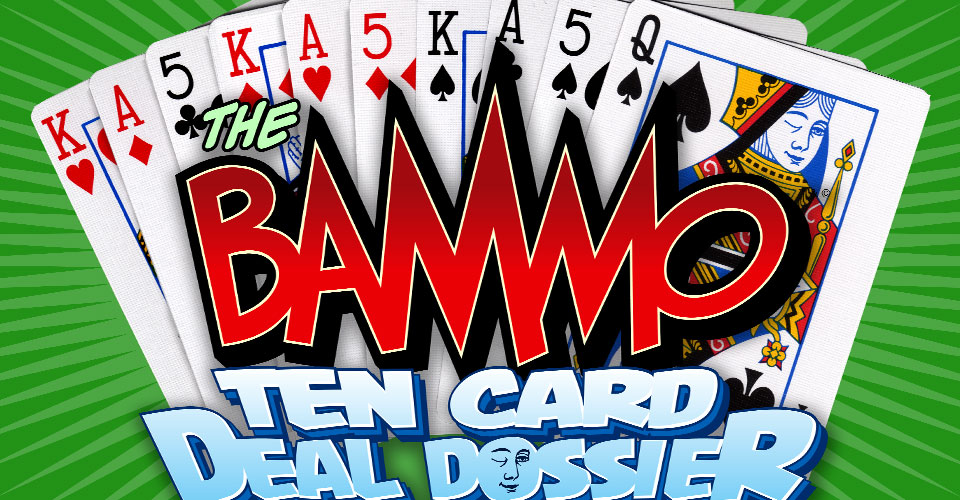
FROM MEXICO, WITH LOVE
BY STEVE BRYANT, FROM LITTLE EGYPT MAGIC, APRIL 2015
EARN BIG MONEY IN YOUR SPARE TIME—The Bammo Ten Card Deal Dossier is Bob Farmer's long, long, long awaited study of the Ten Card Poker Deal, or, as I first heard it called, Mexican Poker.
This oversized book of 400 pages is a monster compendium of methods, presentations, and variations on the title demo, the fascinating poker deal that most guys my age first encountered either in Vernon's Inner Secrets of Card Magic or Harry Lorayne's Deck-Sterity.
I'll be honest: when ordering this book, I figured to merely skim it and keep it on the shelf as a reference. Alas, Bob Farmer's is one of the most compelling voices on the Genii forum, and I found myself reading deeper and deeper, mostly in Bob's voice, occasionally in that of others such as Harry Lorayne's. What could have been dry reading instead makes fascinating reading.
Organizing so much material must have been a staggering challenge.
Bob chose
(1) The Ten Card Deal (272 pages) with such topics as stratagems; one-, two-, eight-, and eighteen-Jonah methods; and the complete Phoenix and MAGIC magazine issues on the subject;
(2) Deals with Ten Cards (52 pages) with deals leading up to and beyond the Solomon-Bannon-Blomberg deal (my favorite; more on that later);
(3) Blackjack Deals (35 pages);
(4) Switches (15 pages) with over half a dozen clever small packet switches; and
(5) References (19 pages) with a fascinating book-in-itself bibliography of every Ten Card Deal known to well-posted man. Or woman. Some of the finest minds in magic made the list, the most prolific and creative being Nick Trost.
Rather than attempt to weigh the value of individual routines, I'll stick with only those that have impressed me along the way, that I hope to include, or that I have included in my own work.
I first saw the Solomon et al version on television in the hands of Alain Nu. Ever since, I have used Alain's idea of distributing the cards between two spectators rather than being the winner myself. More recently, most have seen Ricky Jay perform Jon Racherbaumer's (Losing) End Poker on "The Tonight Show." And I was among a lecture crowd of magicians who were fried by Patrick Redford's 30 Card Poker Deal (one of the few tricks described but not taught in the book).
I can picture but have not seen the Harry Anderson version described in the book but have no doubt the Trost gaffed version, as suggested, would do the trick. I was similarly impressed by a Twisting the Aces routine that Jon Racherbaumer performed, having no clue that Jon would be so underhanded as to ring in Trost gaffs.
Despite my years of reading Ten Card Poker routines, there was plenty that was new to me, and I look forward to trying out Lewis Jones's Give Me Five, Nicholas Johnson's Meet and Greet, and, especially, David Britland's Last Game.
Of versions I've learned, I fondly recall kneeling in a hotel corridor in Columbus as Josh Jay taught me his 242 2.0, a blackjack and poker routine.
But my longtime favorite remains The Blomberg Variation. These days, I prefer to get stuck with the nine. I turn up the spectator's cards to reveal his full house, aces over. Then I turn up four of the my cards to reveal a building straight flush. "I must confess, I tried to stack the cards so that I would get the ace of spades. Bastard! Unfortunately, only one card in the deck could possibly help me now. Fortunately, I have it." And turn over the nine.
As mentioned, I prefer to do the demonstration for two speks, one of them ("the lucky one") being the winner. Alas, I recently performed it one on one for a six-year-old granddaughter. Her elation was so great when her choices resulted in a strong full house that it crushed her heart when I revealed my straight flush. It was a moment that I could not undo and so vowed to never do it that way again. Be forewarned.


